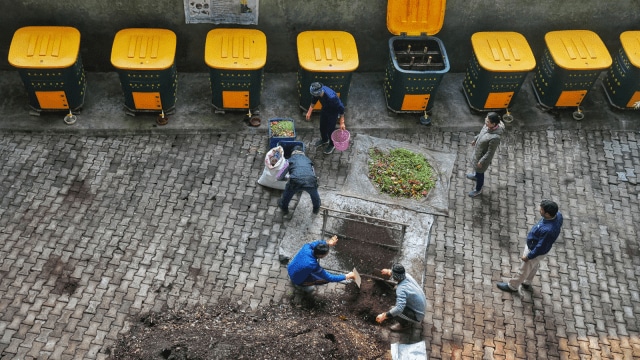From a South Delhi colony, no garbage has landed in the landfills in the last 6 years. Here’s how
Thanks to the efforts of the 280 families residing in the society, of the over 225 kg of waste produced per day in the society, not even a single leaf has ended up in landfills in the last six years.
 Thanks to the efforts of the 280 families residing in the society, of the over 225 kg of waste produced per day in the society, not even a single leaf has ended up in landfills in the last six years.
(Express photo by Abhinav Saha)
Thanks to the efforts of the 280 families residing in the society, of the over 225 kg of waste produced per day in the society, not even a single leaf has ended up in landfills in the last six years.
(Express photo by Abhinav Saha)For the residents of Navjivan Vihar residential society in South Delhi’s Malviya Nagar, mornings usually begin by scrupulously separating dry waste from wet waste. What follows is an earnest wait for a cycle rickshaw and a familiar face – Mujahir Ali, a man responsible for the society achieving the “zero waste” status.
Attached to Ali’s cycle rickshaw are four containers. These are not ordinary containers – each day, they carry 125 kg of wet waste and kickstart the process of attaining the miracle of Navjivan Vihar’s circular waste economy. Adjacent to the containers is a gunny bag filled to the brim with dry waste – weighing around 100 kg.
Thanks to the efforts of the 280 families residing in the society, of the over 225 kg of waste produced per day in the society, not even a single leaf has ended up in landfills in the last six years.
Contrast this to the rest of Delhi – of the 11,342 tonnes of solid waste generated per day, 33.5% is dumped in landfills and 66.5% is processed or treated according to a recent Delhi Polution Control committee report. While around 10% of the waste contains plastic (half of which is single use plastic), 1% to 4% is hazardous waste.
From Ali’s rickshaw, the wet waste travels to 10 ‘Gaia 800’ organic waste converters (bins) kept inside the society – purchased for Rs 6 lakh (including one year consumables) after the residents pitched in. All the wet waste is converted into compost inside these bins. Following this, the compost is used as fertilizer in the three parks of the society.
 Navjivan Vihar society in Delhi (Express photo by Abhinav Saha)
Navjivan Vihar society in Delhi (Express photo by Abhinav Saha)
The dry waste, meanwhile, ends up being given to recyclers in exchange for other goods. “All the paper waste produced here is sent for recycling, and we are given notebooks in return by the recycling firm. We give these notebooks to MCD (Municipal Corporation of Delhi) schools,” Dr Ruby Makhija, secretary of NavjivanRWA (Residents Welfare Association), told The Indian Express
“Around 60% (by weight) of the waste produced here is wet and 40% is dry. Plastic waste forms just 7% of the total waste… We make sure to use as little of single-use plastic as possible,” Makhija added.
Some of the plastic waste, however, has ended up getting recycled and transformed into two sturdy benches located inside the society.
The dry waste in the society, barring sanitary and hazardous waste that comprises less than 2% of the total produce, ends up getting recycled. The MCD ensures this waste goes through incineration.
In Navjivan Vihar, from a damaged speed breaker to chopped off cable wires, all waste items are either turned into compost or recycled. Clothes, footwear and other accessories that are no longer in use are picked up by an NGO twice a month.
 Navjivan Vihar society follows a ‘zero waste’ model (Express photo by Abhinav Saha)
Navjivan Vihar society follows a ‘zero waste’ model (Express photo by Abhinav Saha)
While the close knit community of cleanliness aficionados have played their part in achieving this miracle, the main faces behind the ‘zero waste’ society are three gardeners, three garbage collectors and three cleaners.
So deeply appreciated are these workers that each of the three parks in the society is named after the gardeners – Sonu’s Park, Pappu’s Park and Chedi Lal’s Park. “Everything that we grow in the parks comes from our own gardens. We hardly buy any seeds from outside,” said Gopa, the horticulture head of the society.
The carefully curated garden is home to everything from basil to poppies. The only exceptions are fruits, which are avoided due to a fear of monkeys.
Adjacent to many plants are metallic placards, with their sticks buried no more than six inches into the ground next to the roots of the plant. On these are names of children who adopted these plants on their birthdays and are today nurturing them.
Areas inside the society that used to get flooded after rain have been turned into rainwater harvesting pits. As of today, nine such pits exist in the society. Also, aerators are used in water taps at homes to reduce water pressure and to ensure its judicious use.












